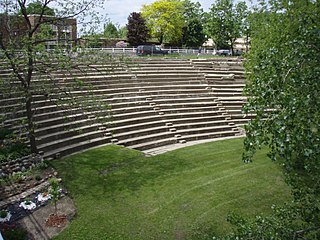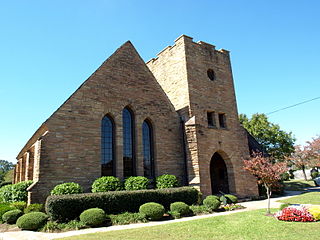
An amphitheatre or amphitheater is an open-air venue used for entertainment, performances, and sports. The term derives from the ancient Greek ἀμφιθέατρον, from ἀμφί, meaning "on both sides" or "around" and θέατρον, meaning "place for viewing".

Red Rocks Amphitheatre is an open-air amphitheatre in the western United States near Morrison, Colorado, approximately ten miles (16 km) southwest of Denver, which owns and operates it. In addition to several other large sandstone formations nearby, the venue is best recognized by its two massive monoliths, named "Ship Rock" and "Creation Rock", as well as the smaller "Stage Rock", which together flank its 9,525 capacity seating area and naturally form the amphitheater. While the venue is primarily known for hosting concerts and music festivals, other events of various types and sizes are held throughout the year.

Red Rocks Park is a mountain park in Jefferson County, Colorado, owned and maintained by the city of Denver as part of the Denver Mountain Parks system. The park is known for its very large red sandstone outcrops. Many of these rock formations within the park have names, from the mushroom-shaped Seat of Pluto to the inclined Cave of the Seven Ladders. The most visited rocks, around Red Rocks Amphitheatre, are Creation Rock to the north, Ship Rock to the south, and Stage Rock to the east.

Universal Amphitheatre was an indoor amphitheatre located in Los Angeles, California within Universal City. It was built as an outdoor venue, opening in the summer of 1972 with a production of Jesus Christ Superstar. It was remodeled and converted into an indoor theatre in 1982 to improve acoustics. The amphitheater closed on September 6, 2013 and was demolished for The Wizarding World of Harry Potter attraction at Universal Studios Hollywood.

Saratoga Spa State Park is a 2,379-acre (9.63 km2) state park located in Saratoga County, New York in the United States. The park is in the City of Saratoga Springs, near US 9 and NY 50.
Mesker Amphitheatre was a historic 8,500-seat amphitheater, located in Evansville, Indiana, United States. It contained 5,500 chair back seats before they were removed and 3,000 lawn seats and is located at Mesker Park, near the Mesker Park Zoo.
The William Randolph Hearst Greek Theatre, known locally as simply the Greek Theatre, is an 8,500-seat Greek Theatre owned and operated by the University of California, Berkeley in Berkeley, California, United States.

The Cynthia Woods Mitchell Pavilion, sometimes called The Woodlands Pavilion or simply The Pavilion, is a concert amphitheatre located in The Woodlands, Texas, an outer suburb of Houston, Texas. It caters to both the performing arts and contemporary artists and is also available for rental. It is owned and operated by The Center for the Performing Arts at The Woodlands and is a non-profit organization. In March 2014, Huntsman signed a five year contract to be the pavilion's presenting sponsor. The amphitheatre seats 16,500 people and has been the second-most heavily used amphitheater in the world. The venue features 6,500 covered seats and up to 10,000 uncovered lawn capacity.

Irvine Meadows Amphitheatre was an amphitheater operating from 1981 to 2016 in Irvine, California.
Legion Park may refer to:

Windego Park Auditorium/Open Air Theater is an amphitheater in Anoka, Minnesota, located on the Rum River. The theater was built in 1914 and was spurred by the City Beautiful movement, as well as Anoka citizens' interest in outdoor entertainment and recreation. Its main organizer, Thaddeus P. Giddings, was a promoter of music education and had been organizing community singalongs in the summer of 1913. The theater is listed on the National Register of Historic Places.

The Greek Amphitheatre is an open-air amphitheater on the campus of Southern Arkansas University (SAU) in Magnolia, Arkansas. Located at the southeastern corner of the campus, it is the only performance space of its kind in southern Arkansas, and has regularly been the site of university events. It was built in 1938 by a combined effort of the National Youth Administration, and New Deal works program, and the 1936 graduating class of Magnolia A & M, as SAU was then called. It has a seating area 103 feet (31 m) wide and about 83 feet (25 m) deep. All of its major elements, including the seating area and stage, are made of concrete.

The Soldiers and Sailors Memorial Coliseum is a multi-purpose auditorium and meeting space in downtown Evansville, Indiana.

The Sylvan Theater Historic District, also known as Greenwood Park Outdoor Theater, is located in Des Moines, Iowa, United States. It has been listed on the National Register of Historic Places since 1995.

The San Antonio Municipal Auditorium was a building located at 100 Auditorium Circle, San Antonio, Texas. It was built as a memorial to American soldiers killed in World War I.

The Forrest Cemetery Chapel and Comfort Station are historic structures in Gadsden, Alabama. The chapel, comfort station, and cemetery gates were built in 1935 by workers from the Works Progress Administration, and designed by local architect Paul W. Hofferbert, who also designed the Legion Park Bowl. The chapel is designed in Gothic Revival style, with a steeply pitched gable with three lancet arched windows and a square tower with lancet arch opening for the entrance. The front gate columns and wall are connected to a hipped roof comfort building, which originally housed restrooms, but is now used for storage. All three are constructed of rough-cut sandstone blocks quarried from nearby Lookout Mountain. The buildings were listed on the Alabama Register of Landmarks and Heritage in 1988 and the National Register of Historic Places in 1992.

Pilot Knob State Park is located southeast of Forest City, Iowa, United States. Founded in 1923, it is one of the oldest state parks in Iowa. Between 1990 and 1995 one area was named nationally recognized historic district and five structures were individually listed on the National Register of Historic Places.
The Cadence Bank Amphitheatre is an outdoor amphitheatre within historic Chastain Park in Atlanta, Georgia. The venue, designed by Nelson Brackin, opened in 1944 and is decreed "Atlanta’s Oldest Outdoor Music Venue". The venue attracts more than 200,000 spectators per season.
FivePoint Amphitheatre was an amphitheatre at the Orange County Great Park in Irvine, California. It opened in 2017 as a replacement for the defunct Irvine Meadows Amphitheatre. With 6,500 bleacher seats, 280 VIP seats, and an approximate 5,500 standing room spaces, it was the largest amphitheatre in Orange County by overall capacity and second-largest in seated capacity, only behind the Pacific Amphitheatre in Costa Mesa. The site is owned by real estate development group FivePoint and was operated by Los Angeles–based concert promoter Live Nation. The facility consisted of three temporary bleacher sections and a temporary stage with future plans to establish a more permanent amphitheatre on the Great Park premises.
The Noojin House is a historic house in Gadsden, Alabama. The house was built in 1926 and substantially renovated and expanded in 1940–41 in French Eclectic style. The two-story three-bay original façade has a centered entrance covered by a copper awning. To the left (west) of the entrance is a two-story arched window. The recessed 1940s one-and-a-half-story addition is further to the left, with a porch under a gable roof with three dormers flanked by a porte-cochère connecting to a garage. A 1980s addition enclosed the rear porch into a grand room with views of the city and the Coosa River.


















